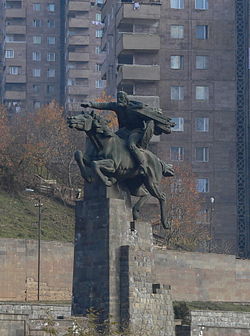- David Bek
-
- For the Armenian municipality, see David Bek, Armenia.
David Bek
Դավիթ Բեկ
A monument to David Bek in Kapan.Born ? Died 1728 Allegiance Armenian national movement Years of service 1722-1728 Rank Bek David Bek (Armenian: Դավիթ Բեկ) (?-1728) was an Armenian military commander and one of the most prominent military figures of the Armenian liberation movement of the 18th century against the forces of Safavid Iran and the Ottoman Empire.[1] In 1722-25 with direct support from Mkhitar Sparapet and Avan Yuzbashi, he headed the armed struggle of Syunik (particularly from Kapan) and Artsakh Armenians against Safavid Iran. In 1726-28 Armenians under the leadership of Bek fought with Ottoman forces, that were attempting to conquer Transcaucasia.
Contents
Biography
Little is known about Bek's early life.[2] He was of noble lineage and prior to the period of armed struggle against the Persians and Turks, Bek served in the royal court of Georgian king Vakhtang VI. Peter the Great's advance south towards the Caucasus with a massive 30,000 man army had revived hope among the Armenians and Georgians that Russian arms could help clear the region from Muslim dominion.[3] Muslim misrule in the regions of Kapan and Artsakh (Karabakh) had provoked the Armenian meliks in 1722 to request military aid from Vakhtang.[4] Vakhtang sent a small force under the command of Bek to Syunik and Bek was successful in dislodging the Turkic nomadic tribes there.
Encouraged by his successes and the weakening of Safavid rule, many Armenians rose the banner of revolt against the Muslims and joined Bek's ranks. The meliks of Karabakh soon joined the cause for national liberation, lending Bek men and materiel; Avan Yuzbashi, a military commander from Shusha who was to become one of Bek's close supporters, contributed 2,000 men to the war effort. As his successes mounted, he awarded them by distributing the lands he seized from the Muslims to his closest supporters.[1] The Persian armies sent to crush the rebellion were repelled, allowing Bek to establish an administrative center at the fortress of Halidzor near Kapan in the Syunik Province.[1] The defensive aspects of the fortress gave Bek's soldiers an advantage when fighting the enemy. He died at Halidzor after coming down with an illness in 1728 and is reputedly buried in the cemetery just outside of the fortress.
Popular culture
In 1944, at the height of World War II, David Bek the movie was filmed by director Hamo Beknazarian with Hrachia Nersisyan starring as David Bek. In 1978 Armenfilm in association with Mosfilm produced another movie about the efforts of David Bek and Mkhitar Sparapet called Star of Hope. David Bek was portrayed by Georgian actor Edisher Magalashvili.
Bek was the subject of an opera, David Beg, composed by Armen Tigranian.
Notes
- ^ a b c Parsamyan, Vardan A. «Դավիթ Բեկ» (Davit Bek). Armenian Soviet Encyclopedia. vol. iii. Yerevan: Armenian Academy of Sciences, 1977, pp. 302-303.
- ^ Bournoutian, George (1997). "Eastern Armenia from the Seventeenth Century to the Russian Annexation" in The Armenian People From Ancient to Modern Times, Volume II: Foreign Dominion to Statehood: The Fifteenth Century to the Twentieth Century. Richard Hovannisian (ed.) New York: Palgrave Macmillan. p. 88. ISBN 1-4039-6422-X.
- ^ Hewsen, Robert (2001). Armenia: A Historical Atlas. Chicago: Chicago University Press. pp. 163–165. ISBN 0-2263-3228-4.
- ^ Bournoutian. "Eastern Armenia", p. 88.
Further reading
- "The Armenian Rebellion of the 1720s and the Threat of Genocidal Reprisal", Armen Ayvazyan
- Harutyunyan, P. T. The liberation movement of Armenian people in the first quarter of the XVIIIth century. Moscow, 1954.
Categories:- Armenian nobility
- 1728 deaths
Wikimedia Foundation. 2010.
